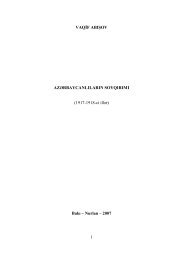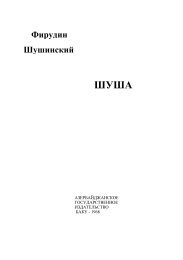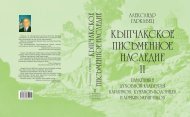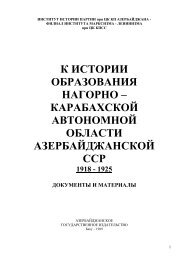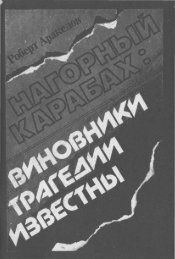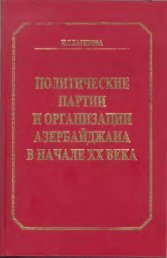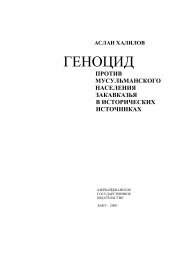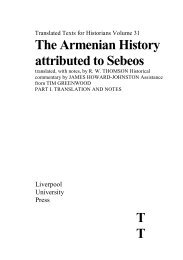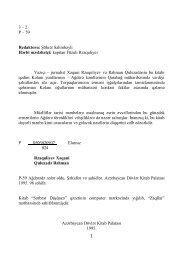ARMENIAN - Erevangala500
ARMENIAN - Erevangala500
ARMENIAN - Erevangala500
Create successful ePaper yourself
Turn your PDF publications into a flip-book with our unique Google optimized e-Paper software.
URARTIANS: THEIR LANGUAGE AND THEIR HERITAGE<br />
We learn from the Assyrian records that, as early as 1274<br />
B.C., Salamassar 1 (1274-1245) invades the land of the<br />
Urartu, destroying eight contries and fifty one cities. The<br />
land was apparently divided into several feudal states<br />
lacking a central authority. According to Prof.<br />
Goodspeed, Shalmaneser crossed the waters of the Upper<br />
Tigris and marched along the southern spurs o f the<br />
(Taurus) mountains tothe nead-waters o f the Euphrates,<br />
where the chief peoples conquered by him were the<br />
"Arami", the Arameans of the western Mesopotamia. His<br />
son, Tukulti-Ninurta I (1244-1208), conquered the<br />
"Nairians" in eastern Anaotolia, defeated forty kings, put<br />
the lands o f the Upper Sea (Lake Van) under his dominion<br />
and forced them to pay tribute. Tiglat-Pleser. Who<br />
describes in his inscriptions a victory (1114 B.C.) over a<br />
united force o f twenty-three Nairi princes, mentions also<br />
the name of Urartu together with that of Mushki and<br />
Milit. We have already referred, in Chapter 7, to the Nairi<br />
indicating the possibility that they may be the Neuri of<br />
Herodotus, a Scythian tribe. We also pointed out our<br />
belief that the Nairi is represented in the Scriptures under<br />
the name o f Nahor, brother o f Abraham and father of Uz.<br />
We had also analyzed the name and showed that its etymology<br />
was Turkish: singular Nair (Neur, Nahor > n-air<br />
fn-eur 'n-ahor) > Turk. On-Ur/On-Gur/On Oghur ("Ten<br />
Oghur ) which is an name given later to the Hungarians.<br />
Silahi Diker : “TEN THOUSAND YEA RS OF THE TURKS<br />
AND THE WHOLE EARTH WAS OF ONE LANGUAGE”<br />
The domination o f East and Southeast Anatolia by the<br />
Assyrians thus continued for a few centuries. By 900<br />
B.C., a new situation is observed:<br />
"Civilization was on the rise again in eastern Asia Minor<br />
where appeared the "Kingdom o f Urartu ", a native kingdom<br />
that worshipped Hurrian gods, including Teshup,<br />
and spoke a language akin to Hurrian; its people were<br />
excellent builders and workers in metal, who on a Hittite<br />
[really Hattia/Hurrian] foundation developed more brilliant<br />
culture than this region has ever known."<br />
10<br />
The people of the land of Urartu called it Khaldia after<br />
the name of its god Khaldis. but to the Assyrians it was<br />
known as Urartu or Uruatri. During the reign o f Sardur II<br />
(764-735) the Urartian state reached its most extensive<br />
limits. Remains o f Urartian settlements have been found<br />
in the lands extending from Gok^egolu-Bayburt in the<br />
north, Malatya in the west, Aleppo and Musul in the<br />
south, and Lake Urmia or even the Caspian Sea in the<br />
east.<br />
Assyrian king Sargon II, in 714 B.C., intended to deal<br />
with the threat of the Urartians. Althrough he defaeted<br />
Rusa I, who committed suicide, and made peace with<br />
them, he declared in his inscriptions that the Urartian<br />
army had the best-trained horses in the world. "In advancing,<br />
wheeling, retreating, or battle disposition, they are<br />
never seen to break out of control." The Assyrians in this<br />
battle had probably the help o f the Cimmerians.<br />
According to Prof. Erzen, the Hurrians and the Urartians<br />
had their roots in the same ancient eastern Anatoian<br />
Chalcolithic culture and that they might even have come<br />
as two branches of the same race having a language neither<br />
Semitic nor Indo-European but rather an Asian language<br />
agglutinative in general form. In fact, the Urartian,<br />
due to its word creating capacity by adding suffixes to a<br />
given root, has similarities with the Ural-Altaic languages.<br />
Further, the gods and the godesses of the Hurrians and the<br />
Urartians arre of the same origin. For exemple, Teisheba,<br />
one of the main geities of the Urartians, is the Hurrian<br />
chief god Teshup the Storm-god. The wives of these gods<br />
are Huba and Hepat respectively. Urartian sun god<br />
Shivini is identical to the Hurrian Snimigi. Capital city of<br />
Urartu, today's "castle" of the city of Van, was Tusnpa,<br />
related to the godess Tushpuea.<br />
Oldest Urartian cuneiform inscriptions found are from the<br />
end of ninth century B.C. However, Aramaic inscriptions<br />
are also found in the ruins o f the Urartian city of<br />
Teishebaini (Karmir Blur) which was apparently<br />
destroyed by the Scythians. The effect of the Urartian<br />
script, together with their culture and civilization, on the<br />
neighbouring peoples is also stressed by Prof. Frye who<br />
notes:<br />
"It has been suggested that one must look fo r the origins<br />
o f much o f the Achaemenid art, architecture and even<br />
state protocel and writing in Urartu."<br />
We have shown below, in the glossaiy, that the names of<br />
Urartian gods and goddesses, of their cities, and of their<br />
kings, whose names in order of their rule are<br />
Aram/Aramu (ab. 840 B.C.), Lutipri (father of Sarduri I),<br />
sarduri I (830-825 B.C.), Ishpuini/Ushpina (825-815),<br />
Menua I (815-790), Argishti I (790-765), Sardur II (764-<br />
735), Rusa 1 (735-714), Argishti II (714-685), Russsa II<br />
(685-645) Sarduri III (645-635?), Sarduri IV (635?-?),<br />
erimena (father of Rusa III) and Rusa III (last years o f the<br />
7th century B.C.), all can be explained in Turkish



